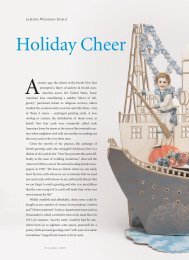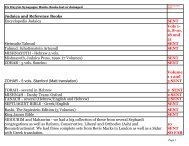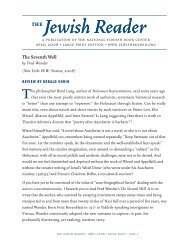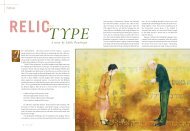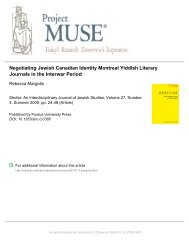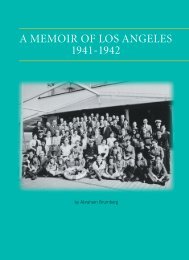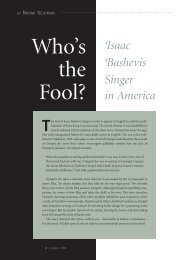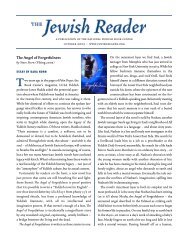The Life and Art of Boris Aronson - Yiddish Book Center
The Life and Art of Boris Aronson - Yiddish Book Center
The Life and Art of Boris Aronson - Yiddish Book Center
You also want an ePaper? Increase the reach of your titles
YUMPU automatically turns print PDFs into web optimized ePapers that Google loves.
streets, or other real-world locations. Instead, set designersthought like sculptors or architects, crafting three-dimensionalplaying spaces where the actors could move about onmultiple levels. <strong>The</strong>y arranged abstract geometric shapes<strong>and</strong> masses to construct symbolic expressions <strong>of</strong> a play’semotional essence. In keeping with the philosophy <strong>of</strong> totaltheatricality, the set <strong>and</strong> costume designer for a Kamernyplay worked intimately with the director from the earliestplanning stages <strong>of</strong> a production. <strong>The</strong> look <strong>of</strong> the play wasnot a decorative add-on, but an integral part <strong>of</strong> the show’soverall concept.An affinity for nonrepresentational stage design, a preferencefor sets that did not confine the action to a singlelevelplaying area, <strong>and</strong> a vision <strong>of</strong> the designer as a fullfledgedcollaborator with the director – all these legacies <strong>of</strong>his Kamerny experience were to have a pr<strong>of</strong>ound influenceon <strong>Aronson</strong>’s subsequent career.<strong>The</strong> Soviet Union’s hospitality to abstract <strong>and</strong> experimentalart did not last long. Socialist Realism soon becamethe nation’s <strong>of</strong>ficial aesthetic doctrine, <strong>and</strong> Stalinist purgesdealt harshly with artists whose work was deemed bourgeois,decadent, or unsuitable for government-approvedpropag<strong>and</strong>a purposes. <strong>Aronson</strong> avoided the unhappy fate<strong>of</strong> many fellow artists by fleeing the country in 1922.He settled for a short time in Berlin, where he exhibitedhis paintings <strong>and</strong> published two books, one <strong>of</strong> which was astudy <strong>of</strong> Jewish graphic art. In his native country, <strong>Aronson</strong>,temporarily using the name “Baruch <strong>Aronson</strong>,” had beenaffiliated briefly with a group <strong>of</strong> Jewish artists who lookedto traditional shtetl folk art, such as primitive woodblockprinting, <strong>and</strong> to non-representational design motifs, suchas the decorative patterns on prayer shawls <strong>and</strong> skullcaps, askeys to an explicitly Jewish style <strong>of</strong> abstract art. Now, however,<strong>Aronson</strong> used his book to argue that there was nottruly any such thing as “Jewish art,” that a people so dispersedamong many nations could not lay claim to a signatureaesthetic tradition distinct from the art <strong>of</strong> the dominantcultures around them.<strong>The</strong> other book <strong>Aronson</strong> published during his residencein Germany was about fellow artist Marc Chagall, withwhom he had fo rmed an important friendship back inRussia. Chagall was a decade older than <strong>Aronson</strong>, but thetwo had a great deal in common. Both were deeply interestedin Russian Jewish folk art, <strong>and</strong> both had exercisedtheir talents not only as painters but also as Moscow theatricaldesigners. Years later, married <strong>and</strong> living in theUnited States, <strong>Aronson</strong> would name his son Marc.<strong>The</strong> modest financial su ccess <strong>of</strong> his two books madeit po s s i ble for Aron s on to set out ac ross the At l a n ticfor New York Ci ty in 1923, a metropolis that lived in hisi m a gi n a ti on as a rom a n tic cen ter <strong>of</strong> tech n o l ogical soph i sti c a-ti on <strong>and</strong> cultu ral vi t a l i ty, “a new worl d ,” as he conceived it,wh ere an artist would be able to work “on a l a r ger, f reers c a l e .”His decision to seek his first A merican work in the<strong>Yiddish</strong> theatre was driven by practical considerations. Forthose first few years in New York, he simply didn’t haveenough English to read scripts <strong>and</strong> contracts, or even toconverse with actors <strong>and</strong> directors. Nor was he sufficientlysteeped in the look <strong>and</strong> feel <strong>of</strong> his adopted country to beconfident about his ability to express the American experiencein his designs. But, in the <strong>Yiddish</strong> theatres located inthe Bronx <strong>and</strong> on Manhattan’s Lower East Side, <strong>Aronson</strong>found a community <strong>of</strong> fellow artists <strong>and</strong> European immigrantswho shared his familiarity with the avant-garde artinnovations that were still years away from gaining accepta n ce in the com m ercial mainstream <strong>of</strong> New York’sEnglish-language theatre industry. To Broadway producers<strong>and</strong> directors <strong>of</strong> the 1920s, the young Russian’s approach tostage design was, in the words <strong>of</strong> a writer for <strong>The</strong> Nation,“an exotic <strong>and</strong> transplanted thing” that was bound to limithis appeal, notwithst<strong>and</strong>ing “<strong>Aronson</strong>’s technical pr<strong>of</strong>iciency,his intelligence, <strong>and</strong> his ingenuity.”It was not until 1932 that Broadw ay ’s imagi n a ti on caugh tup with the exo tic intell i gen ce <strong>of</strong> <strong>Boris</strong> Aron s on . He wash i red that year to de s i gn the va u devi ll e - s tyle musical revu eWalk a Little Fa s ter, the first <strong>of</strong> his many com m i s s i ons forthe musical stage . Over the next several dec ade s , Aron s on<strong>of</strong> ten found that mu s i c a l s , opera s , <strong>and</strong> ball et s , with thei ri n h erent dep a rtu res from the literal ren d i ti on <strong>of</strong> re a l i ty, weree s pec i a lly com p a ti ble with his theatrical vi s i on .Aron s on unders tood that a Broadw ay career would frequen t ly entail com promise on his part , that he would haveto come to terms with the need for re a l i s tic repre s en t a ti onin his de s i gns for certain shows . In many <strong>of</strong> the sets hede s i gn ed after leaving the <strong>Yiddish</strong> stage for the wi derworld <strong>of</strong> E n gl i s h - l a n g u a ge theatre , the lessons he hadl e a rn ed at the Ka m erny ex pre s s ed them s elves in su bt l eto u ches ra t h er than full - bl own abstracti on . For ex a m p l e ,even wh en de s i gning a pri m a ri ly re a l i s tic set , he <strong>of</strong> tens c u l pted the three - d i m en s i onal stage space by incorpora t-ing ramps <strong>and</strong> other devi ces that en a bl ed actors <strong>and</strong> directorsto invi gora te the play with acti on on more than on el evel . Because he con ti nu ed to work as a painter wh i l ep u rsuing his career in the theatre , he maintained a stron gs ense <strong>of</strong> the con n ecti on bet ween the physical re a l i ty <strong>of</strong>co l or <strong>and</strong> the em o ti onal re a l i ties <strong>of</strong> a play wri gh t’s scri pt .8 S P R I N G 2 0 0 5



